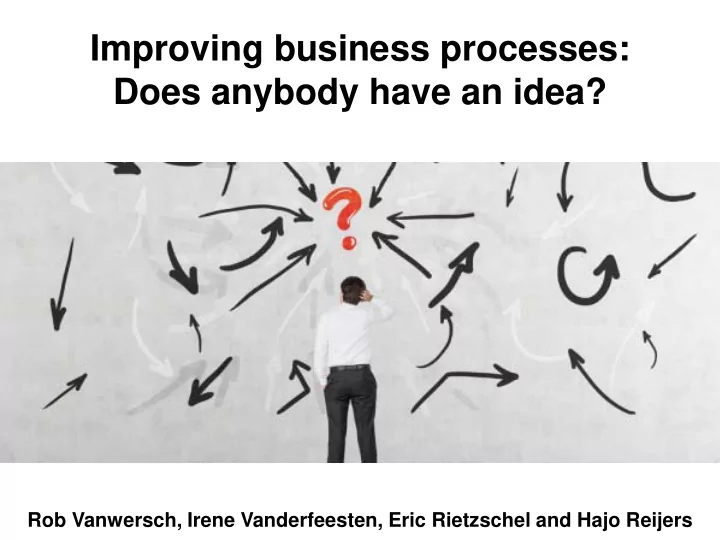

Improving business processes: Does anybody have an idea? Rob Vanwersch, Irene Vanderfeesten, Eric Rietzschel and Hajo Reijers
Problem statement Months are spent on discovering / analyzing an AS-IS process systematically A few hours are spent on generating improvement ideas intuitively ( TO-BE )
Typical current practice Does anybody have an idea? Does anybody have an idea?
Problems of traditional brainstorming No safeguard for a systematic / comprehensive exploration of potential solution space Practitioners rely on personal experience and intuition (1) Biased choices (2) Attractive ideas are missed Full redesign potential is not realized
Aren’t there any alternatives for traditional brainstorming? Yes, there are: • BPR best practices • TRIZ innovation principles • MIT Process Handbook • Etc.
But what do we know about these alternatives? That these alternatives seem to perform well in case- studies.
How to continue? Shouldn’t we be more interested in whether these alternatives outperform existing techniques (i.e. traditional brainstorming)? It’s time for a first controlled experiment in this area!
Our lab experiment TRIZ BPR VS RePro Traditional RePro brainstorming
The RePro technique General rules of thumb General General problem solution Specific Specific problem solution
The RePro technique 1. Self-service: ‘Move tasks towards the customers’ By moving checks and other operations that are part of a business process to the customer, cost can be reduced and customer satisfaction might increase. A disadvantage of this solution is a higher probability of fraud. Example: Ask the patient, instead of the nurse, to pick up the drugs by the hospital pharmacy.
Service concept Examples: - Self-service - Outsourcing External Customers environment Main process design Examples: - Task elimination - Prior action Tasks Detailed process design Examples: - Parallelism - Case manager Task order and Human resources timing Facilities / equipement / ICT material Physical Information lay-out
Set-up lab experiment TRIZ BPR VS RePro Traditional RePro brainstorming
Experiment participants 99 students Industrial Engineering
Experiment factor and factor levels Control Manipulation (TB) (RePro) 1C 1M Individuals (44) (45)
Experiment task Generating process improvement ideas for “real-life” cataract surgery process.
Experiment information-set Plenary video message Case description including: o Improvement objectives o Process models and descriptions o Process and waiting times o Cost information o Problems identified by employees and patients Technique description (RePro / brainstorming) Digital post-experiment questionnaire
Experiment response variables Productivity: number of unique ideas generated Satisfaction with the technique (Likert 1-7) Intention-to-use the technique (2-item Moody (2003); Likert 1-7)
Experiment hypotheses H1: The RePro technique supports individuals in generating more ideas as compared to traditional brainstorming . More complete exploration of the solution space Less cognitive effort to start new train of thought Conformance to technique examples is limited
Experiment hypotheses H2: Individuals using the RePro technique are more satisfied with their technique than individuals using traditional brainstorming. H3: Individuals using the RePro technique have a positive intention-to-use the technique.
And the results are....
H1: Productivity Average number of unique ideas: TB: 14,57 (N=37) RePro: 17,82 (N=44) No support for H1
Follow-up analysis: Productivity Two different styles of using the RePro technique: (1) Opportunity-centric: List of RePro principles Case-description (starting point)
Follow-up analysis: Productivity Two different styles of using the RePro technique: (2) Problem-centric: Problem areas as identifiable List of RePro principles in case-description (starting point)
Follow-up analysis: Productivity Average number of unique ideas: TB: 14,57 (N=37) RePro_Problem-centric: 14,90 (N=31) RePro_Opportunity-centric: 24,70 (N=13)
H2: Satisfaction with technique Average satisfaction with technique (Likert 1-7): TB : 4,70 (N=37) RePro: 5,30 (N=44) Support for H2
H3: Intention-to-use technique Intention-to-use technique (Likert 1-7) Intention-to-use Intention-to-use Intention-to-use Intention-to-use Condition N > 4 = 4 < 4 Average RePro 44 36 (82%) 2 (4%) 6 (14%) 5,1 Support for H3
Conclusions Experiment results confirm potential for using a more advanced technique for generating process improvement ideas. But experiment results also strongly relate the usage style of such a technique to its performance . Further experiments are recommended to investigate effects of different usage styles in controlled setting.
Thanks for your attention! Thanks for Questions / remarks: r.j.b.vanwersch@tue.nl More information: https://robvanwersch.wordpress.com/
Recommend
More recommend